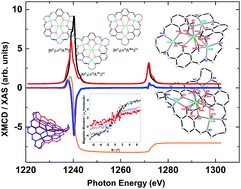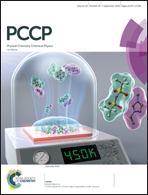Element specific determination of the magnetic properties of two macrocyclic tetranuclear 3d–4f complexes with a Cu3Tb core by means of X-ray magnetic circular dichroism (XMCD)
Abstract
We apply X-ray magnetic circular dichroism to study the internal magnetic structure of two very promising star shaped macrocyclic complexes with a CuII3TbIII core. These complexes are rare examples prepared with a macrocyclic ligand that show indications of SMM (Single Molecule Magnet) behavior, and they differ only in ring size: one has a propylene linked macrocycle, [CuII3TbIII(LPr)(NO3)2(MeOH)(H2O)2](NO3)·3H2O (nickname: Cu3Tb(LPr)), and the other has the butylene linked analogue, [CuII3TbIII(LBu)(NO3)2(MeOH)(H2O)](NO3)·3H2O (nickname: Cu3Tb(LBu)). We analyze the orbital and spin contributions to the Cu and Tb ions quantitatively by applying the spin and orbital sum rules concerning the L2 (M4)/L3 (M5) edges. In combination with appropriate ligand field simulations, we demonstrate that the Tb(III) ions contribute with high orbital magnetic moments to the magnetic anisotropy, whereas the ligand field determines the easy axis of magnetization. Furthermore, we confirm that the Cu(II) ions in both molecules are in a divalent valence state, the magnetic moments of the three Cu ions appear to be canted due to 3d–3d intramolecular magnetic interactions. For Cu3Tb(LPr), the corresponding element specific magnetization loops reflect that the Cu(II) contribution to the overall magnetic picture becomes more important as the temperature is lowered. This implies a low value for the 3d–4f coupling.



 Please wait while we load your content...
Please wait while we load your content...